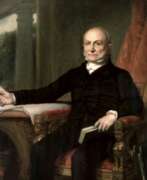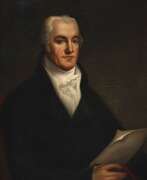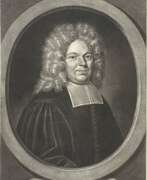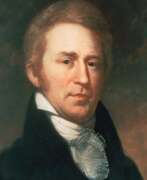Diplomats 18th century


John Quincy Adams was an American politician and statesman, the sixth President of the United States (March 4, 1825 - March 4, 1829).
John Quincy Adams was the son of John Adams, the second President of the United States, and, of course, public service was his destiny. As a child, in 1778 he traveled to France with his father, who was then U.S. Commissioner to France. At the age of 14, Adams became personal secretary to Francis Dana, the U.S. Minister to Russia, serving as his father's secretary as well during the negotiation of the Treaty of Paris (1783). In 1787, the twenty-year-old Adams graduated from Harvard University and, after studying law, began practicing in Boston.
In addition to numerous diplomatic appointments, Quincy Adams served as a U.S. Senator from Massachusetts from 1803 to 1808. President James Madison appointed Adams U.S. minister to Russia in 1809, and Adams served until 1814. And under President James Monroe, he served as Secretary of State from 1817 to 1825 and is considered one of the best Secretaries of State in U.S. history.
John Quincy Adams won the 1824 presidential election in a four-way race against Henry Clay, William Crawford, and Andrew Jackson. As president, Adams supported a program to modernize the U.S. economy. But his popularity declined because of his approach to Native Americans, whom he supported against the demands of settlers from the west.
After losing the 1828 presidential election to Andrew Jackson, John Quincy Adams was elected to the House of Representatives, where he served as a representative from Massachusetts for the next 17 years. In the House of Representatives, Adams became one of the most vocal opponents of slavery. He consistently defended abolitionist views and policies, denouncing slavery as an immoral institution and attacking the interests of Southern slaveholders. During the U.S.-Mexican War of 1848, Adams was a leading opponent of the annexation of Texas, farsightedly predicting that it would lead to civil war.
After suffering two strokes, Adams died on February 23, 1848, at the age of 80. Had fate not predestined him to pursue politics, John Quincy Adams would have become a famous poet. He spent his life composing poems in various genres. After his death, many of his poems were collected and published in Poems on Religion and Society (1848).


Joel Barlow was an American statesman, diplomat, French politician and poet.
A graduate of Yale University, he briefly served as a chaplain in the Revolutionary Army. In 1784, Barlow founded the American Mercury, a weekly newspaper in Hartford, Connecticut, and was admitted to the bar in 1786. Along with John Trumbull and Timothy Dwight, he was a member of the Hartford Witters, a group of young writers.
Joel Barlow's fame was brought to him by his poetic work The Vision of Columbus (1787). It is a dialog between Christopher Columbus and an angel and covers the entire history of America to the end of the American Revolution. The poem was signed by many leading figures of the time, including George Washington and Benjamin Franklin, and was popular on both sides of the Atlantic. The author later reworked the poem into a more cynical epic called Columbiad.
In 1788, Barlow traveled to France as an agent for the Scioto Land Company and persuaded a group of Frenchmen to emigrate to America, who eventually founded the town of Gallipolis, Ohio. In Paris he became a liberal in religion and an advanced republican in politics; he took part in the French Revolution and was granted French citizenship.
In the literary field, Barlow is also known for his work The Hasty Pudding (1796). It is a humorous poem inspired by a longing for New England and cornmeal, containing vivid descriptions of rural scenes.
In 1795-97. Barlow was sent to Algeria on a diplomatic mission and returned to the United States in 1805. In 1811 he was appointed U.S. plenipotentiary to France. Barlow participated in Napoleon's retreat from Russia and died in Poland.


Jacques Basnage de Beauval was a French theologian and historian, diplomat and writer.
His father was a prominent lawyer and his grandfather and great-grandfather were pastors, Jacques studied theology and languages at the Academy of Saumur, then at Geneva and Sedan. In 1676, Jacques Basnage was appointed pastor at Rouen during the revocation of the Edict of Nantes, was forced to flee France for Holland, where he worked as a theologian, polemicist, historian, and diplomat in the service of the Grand Pensioner Hensius.
In 1717, on behalf of Holland, Basnage was sent to sign the treaty of the Triple Alliance (France, Holland, England). In the Annals of the United Provinces (1719-1726), compiled from the peace negotiations held at Münster, he displays breadth of vision, wisdom, and impartiality.
About 1719 Jacques Basnage was appointed historiographer of the Dutch states. He wrote several books on the Bible, the history of the Church, and the history of the Jewish people. Among the best known of these are his History of the Religion of the Protestant Denominations (1690), History of the Church of Jesus Christ to the Present Time (1699), written from Protestant positions, and History of the Jews (1706), as well as Jewish Antiquities, or Critical Notes on the Republic of the Jews (1713).


Joachim Bouvet was a French Jesuit monk and missionary who worked in China.
Joachim Bouvet was one of six Jesuit mathematicians chosen by Louis XIV to travel to China as his envoys and work as missionaries and scholars. In 1687 in Beijing, Bouvet began this work, especially in mathematics and astronomy, and in 1697 the Chinese emperor Kangxi (1654-1722) sent him as ambassador to the French king. Kangxi expressed his wish that Bouvet should bring more missionary scientists with him. Thus, in addition to his scholarly work, Bouvet was also an accomplished diplomat and served as a liaison between the Chinese Emperor Kangxi and King Louis XIV of France.
Bouvet brought to France a manuscript describing Kangxi's life with an eye for diplomatic subtleties, as well as a collection of drawings depicting graceful Chinese figures in traditional and ceremonial dress. The first French edition of The Historical Portrait of the Emperor of China was published in Paris in 1697, and was subsequently translated and published in other languages. And Bouvet returned to China in 1699 with ten new missionaries and a collection of King Louis XIV's engravings for Emperor Kangxi. He remained in China for the rest of his life.


William Clark, an American frontiersman, is best known for co-leading the epic Lewis and Clark Expedition alongside Meriwether Lewis from 1804 to 1806. This journey was a monumental exploration of the American West, extending to the Pacific Northwest, which laid the foundation for westward expansion and significantly contributed to the nation's knowledge of the vast territory.
Before his fame as an explorer, William Clark had a substantial military career, beginning with his service in the militia and the U.S. Army during the Northwest Indian War. His experiences in the military, including participation in the Battle of Fallen Timbers, honed his leadership and survival skills, which were crucial for the success of the Lewis and Clark Expedition.
Following the expedition, William Clark continued to serve in significant roles, including as the governor of Missouri Territory and as a superintendent of Indian Affairs. His later years were dedicated to managing relations with various Native American tribes, navigating the complexities of the expanding American frontier.
For collectors and experts in art, history, and antiques, William Clark's life and contributions offer a fascinating lens through which to explore the early 19th-century American narrative. His maps, journals, and other related artifacts provide a unique perspective on this formative period in U.S. history.
To stay informed about new discoveries, exhibitions, and auction events related to William Clark, consider subscribing for updates. This subscription will provide you with valuable insights into the lasting impact of Clark's legacy on American culture and history.


Charles d'Éon de Beaumont, known as Chevalier d'Éon and with many other names, was a French nobleman, diplomat, and secret agent who belonged to the Royal Secret diplomatic network. This amazing and versatile man was forced to live the second half of his life as a woman by virtue of his activities.
D'Eon participated in the Seven Years' War and spied for France while in Russia and England. In France and England he was known for his adventurous life and his many talents: he was an ambassador and secret agent in the service of Louis XV, a captain of dragoons during the Seven Years' War, a skilled swordsman, and a man of letters. After several missions to Russia, more often under the guise of a woman, he was sent to London in 1762 to assist the ambassador in the peace negotiations with England. For his contribution to the Treaty of Paris, signed the following year, he became a Knight of the Order of Saint Louis.
Needing money, and in order to receive a pension, he increasingly entered the role of a woman. In 1777 he received an order: "By order of the King: Charles-Geneviève-Louise-Auguste-Andrée-Timotheus d'Eon de Beaumont is ordered to remove the dragoon uniform she wears and to dress in accordance with her sex. Henceforth he always wore women's dress. Returning to London in 1785, d'Eon died there 25 years later. An autopsy conducted two days after his death found him to be male.


François Joseph de Pons, full name François Raymond Joseph de Pons, was a French traveler, writer, and diplomat.
De Pons, during his stay in Venezuela in the early 19th century, served as a political and diplomatic correspondent in Caracas, gathering information for the French government. This prompted him to write a book entitled: "A voyage through the eastern part of Terre Ferme, North America, made in 1801, 1802, 1803 and 1804; containing a description of the general chapter of Caracas and the provinces of Venezuela, Maracaibo, Varinas, Española Guiana, Cumana and Margarita Island", which also included a geographical map and plans of the capital Caracas and the main ports.
Contemporaries praised the work as "an important account of Venezuela, containing a description of the country and people, as well as a description of the growth and production of cacao, indigo, sugar, cotton, coffee, and tobacco." The first edition was published in Paris in 1806. This work was so popular and significant that in the same year it was translated by the writer Washington Irving and published in New York and London.


Sir William Douglas Hamilton was a British diplomat, archaeologist and volcanologist, a famous collector, and a Fellow of the Royal Society of London.
He served as British Ambassador to the Kingdom of Naples from 1764 to 1800, but most importantly, he was a passionate researcher of history, art and natural sciences and was a member of the Society of Dilettantes, established for the purpose of studying ancient art.
In Naples, Hamilton amassed a unique collection of antique vases and published an illustrated book about them. In parallel, Sir Hamilton studied the volcanoes Vesuvius and Etna, local volcanic and seismic activity, and the causes of earthquakes in the Neapolitan territory. As a corresponding member of the Royal Society, he sent the results of his research to London. His publications were very valuable for the time.


William Henry Harrison, an American military officer and politician, became the ninth President of the United States in 1841, making history with the shortest presidency due to his death just 31 days after taking office. Born on February 9, 1773, in Charles City County, Virginia, Harrison was the last U.S. president born as a British subject and the paternal grandfather of Benjamin Harrison, the 23rd president.
William Henry Harrison's early military career was marked by notable achievements, including participating in the Battle of Fallen Timbers in 1794, which concluded the Northwest Indian War. His leadership against Tecumseh's confederacy at the Battle of Tippecanoe in 1811 earned him the nickname "Old Tippecanoe." He was later promoted to major general during the War of 1812, securing a significant victory at the Battle of the Thames, which effectively ended the Indian confederation led by Tecumseh.
Before his presidency, William Henry Harrison had a prolific political career, starting in 1798 when he became the secretary of the Northwest Territory. He was then elected as the territory's delegate to the U.S. House of Representatives in 1799. In 1801, he became the governor of the Indiana Territory, where he negotiated numerous treaties with Native American tribes, acquiring vast tracts of land for the United States. Harrison's political journey also included terms in the U.S. House of Representatives, the Senate, and as the U.S. Minister to Colombia before being nominated by the Whig Party for the presidency in 1840.
His presidential campaign was famous for the "Log Cabin Campaign," where Harrison was presented as a man of the people, in stark contrast to the incumbent President Martin Van Buren, who was portrayed as an elitist. This strategy proved successful, and William Henry Harrison won the presidency with a significant margin. However, his time in office was cut short when he died of presumed pneumonia, making his wife, Anna Harrison, the first presidential widow to receive a pension from Congress.
Harrison's legacy is complex, marked by his military and political contributions that significantly impacted the United States' expansion and development during its early years.
For those interested in learning more about William Henry Harrison, signing up for updates is a great way to stay informed about new discoveries and interpretations of his life and contributions to American history. This subscription will alert you to new product sales and auction events related to this significant historical figure, providing a unique opportunity for collectors and experts in art and antiques to deepen their understanding of American history.


David Humphreys was an American soldier, statesman, diplomat, writer, poet, and biographer.
He received his bachelor's degree from Yale University, where he became a member of the Hartford Witters and taught, and went to serve in the Continental Army in the summer of 1776.
A close friend and aide to George Washington, Humphreys was an eyewitness and active participant in the early years of the United States. During his long career, Col. David Humphreys served as a soldier, secretary, diplomat, and was a writer, poet, orator, biographer, and industrialist. His speeches, poems, literary works, and correspondence with Washington and others of the founding generation serve as a valuable source for historians of the early republic in the late eighteenth and early nineteenth centuries.
Because of his intelligence and diligence, David Humphreys had a long record of service and held many public offices, among others serving as U.S. minister to Spain from 1797 to 1801. He was a member of the Royal Society of London and the American Antiquarian Society.


Washington Irving was an American Romantic writer, historian, and diplomat.
Irving has been called "the first American writer" to be recognized in Europe. In 1815, he traveled to England on family business. A huge success in England and the United States was The Sketch Book, published in several installments during 1819-1820, which contained two of the author's most famous works, Rip Van Winkle and The Legend of Sleepy Hollow, and which made him a literary star in both England and the United States.
He continued his literary endeavors and worked at the U.S. Embassy of Great Britain. Returning to the United States in 1832, Irving visited some little-known territories near the western fringes of the country, and this journey inspired his works Journey on the Prairie (1835), Astoria (1836), and The Adventures of Captain Bonneville (1837). Late in life he published several historical and biographical works, including the five-volume Life of George Washington (1855-1859).


John Jay was an American lawyer and diplomat, statesman, and one of the founding fathers of the United States.
Jay came from French Huguenots, after graduating from King's College (now Columbia University) he entered law school and was admitted to the bar in 1768. After the outbreak of hostilities in the spring of 1775, Jay continued to serve both in New York and in the Continental Congress, which elected him president in late 1778.
In the fall of 1779 he was appointed minister plenipotentiary to Spain, which had recently entered into an alliance with France against England. In May 1782 he traveled to Paris, where a treaty was concluded that formally ended the war with Great Britain in 1783. Before returning to America in July 1784, Jay was appointed secretary of foreign affairs.
In 1788, Jay actively advocated for the ratification of the U.S. Constitution by the state of New York. Together with future President James Madison and economist Alexander Hamilton, he participated in the creation of the famous book The Federalist (1788). Under the new Constitution, President Washington appointed John Jay Chief Justice of the United States in 1789, and in July 1795 he became Governor of New York. After completing his second term as governor in June 1801. Jay retired to his farm in Bedford, New York.


Thomas Jefferson was an American politician and statesman, the third President of the United States (March 4, 1801 - March 4, 1809).
Jefferson was the son of a planter and received a law degree. In 1774, he wrote A Summary of the Rights of British America, which attracted public attention, and he soon gained a reputation as one of the first advocates of American independence from the authority of the British Parliament. In the spring of 1775, the Virginia legislature appointed him a delegate to the Second Conference of the Continental Congress. A year later he was appointed to a committee of five, which also included Adams and Benjamin Franklin, to draft a formal statement of reasons to justify a break with Great Britain. Jefferson thus became one of the authors of the Declaration of Independence. Jefferson succeeded Benjamin Franklin as minister to France in 1785, was secretary of state (1790-1793) under Washington, and vice president (1797-1801) under John Adams.
A Democratic-Republican, Jefferson, who believed that the national government should play a limited role in the lives of citizens, was elected president in 1800. One of the most significant accomplishments of Jefferson's first administration was the purchase of the Louisiana Territory from France for $15 million dollars in 1803 (from the Gulf of Mexico to present-day Canada), effectively doubling the size of the United States. During his second term, Jefferson was focused on trying to keep America out of the Napoleonic Wars in Europe. After his second term as president, he was succeeded by James Madison in 1808.
Upon leaving office, Jefferson retired to his plantation in Virginia, pursued his favorite pastimes, and helped found the University of Virginia. In addition to politics, he is known as a writer, farmer, horticulturist, inventor, book collector, art historian, architect, and scientist. He died at the age of 83 on July 4, 1826, the 50th anniversary of the Declaration of Independence.


Gottfried Wilhelm Leibniz was a German philosopher and a prominent polymath in many fields of science.
Leibniz was a universal genius; he showed his talents in logic, mathematics, mechanics, physics, law, history, diplomacy, and linguistics, and in each of the disciplines he has serious scientific achievements. As a philosopher, he was a leading exponent of 17th-century rationalism and idealism.
Leibniz was a tireless worker and the greatest scholar of his time. In the fate of Leibniz, among other things, there is one interesting page: in 1697, he accidentally met the Russian Tsar Peter I during his trip to Europe. Their further meetings led to the realization of several grandiose projects in Russia, one of which was the establishment of the Academy of Sciences in St. Petersburg.
Gottfried Wilhelm Leibniz was also the founder and first president of the Berlin Academy of Sciences and a member of the Royal Society of London.


John Marshall was Chief Justice of the United States Supreme Court from 1801 to 1835, Secretary of State, and one of the founders of the American legal system.
During the Revolutionary War, Marshall served first as a lieutenant and after July 1778 as a captain in the Continental Army. In 1781 he left the service, studied law, and began practicing law in Virginia, in Fauquier County, and then in Richmond. He soon became head of the Virginia bar and was a member of the Virginia assembly. In 1788 he took a leading part in the Virginia convention convened to discuss the proposed U.S. Constitution. In 1797-98, along with Charles Cotesworth Pinckney and Elbridge, Gerry Marshall was appointed by John Adams to negotiate with France.
He was Secretary of State under President Adams from June 6, 1800 to March 4, 1801. At the same time he was appointed Chief Justice of the Supreme Court in 1801 and served in that position until 1835.
John Marshall was a personal friend of Washington, he announced his death in 1799, organized his funeral, and delivered his eulogy. Washington's relatives soon asked Marshall to write a biography of the late president. "The Life of George Washington" was published in London in 1804-1807. It includes illustrations, portraits, facsimile letters, and folding maps.


James Mario Matra, born James Magra, was an American of Corsican descent, diplomat and sailor.
Matra became famous for accompanying James Cook on his first voyage to the Pacific and for painting the voyage, although his participation in it was accompanied by scandal. In 1783 he proposed settlements in New South Wales, Australia, for American Loyalists and British convicts. But Matra's hopes for an official position in the proposed colony failed, and in 1786 he accepted the post of consul in Tangier, where he remained until his death.


Christian Friedrich Schwarz was a German Lutheran missionary to India, a polyglot and diplomat.
Schwarz knew many languages, including Hebrew, Greek, Sanskrit, and Persian. Very young, he set out on a mission to India in early 1750 and was very successful. Schwartz was favorably received by Indian royalty, he taught Raja Serfoji of Tanjore, and was greatly respected by the local people for his good works.
The results of Christian Schwartz's missionary work exceeded all expectations. Schwartz founded several schools in India and had a significant impact on the establishment of Protestant Christianity in southern India. He lived in India until the end of his life and was buried with honors at St. Peter's Church in Maharnonbuhavadi, Thanjavur.


Dominique Vivant, Baron Denon was a French artist, writer, diplomat, author, and archaeologist. Denon was a diplomat for France under Louis XV and Louis XVI. He was appointed as the first Director of the Louvre museum by Napoleon after the Egyptian campaign of 1798-1801, and is commemorated in the Denon Wing of the modern museum and in the Dominique-Vivant Denon Research Center. His two-volume Voyage dans la basse et la haute Egypte ("Journey in Lower and Upper Egypt"), 1802, was foundational for modern Egyptology.





















